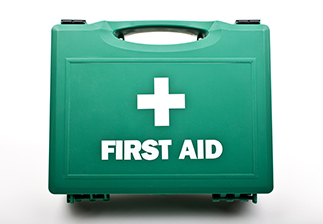Swimming pool first aid
Swimming pool first aid is a necessary skill for any parent who has a swimming child or learning-to-swim baby. Drowning is the second-leading cause of death in children aged 0-15 – accounting for nearly 42% of all fatal drowning cases in South Africa. 
Kids are especially at risk because they are curious and attracted to water, but are not yet able to understand how dangerous it is. If your child is the victim of a near-drowning, a fast-action rescue plan can prevent a tragedy.
A small child can drown in as little as 5 cm of water, just enough to cover their face and nose. You need to make sure that you have some basic first aid equipment around the swimming pool, including a first aid kit and a life preserver of some kind.
What to do in an emergency
If your child has been submerged in the water, your first priority is to get your child out of the swimming pool and then check if they are breathing. If they aren’t, place your child on a hard surface, call for help and start performing CPR. Don’t assume it’s too late to save a child’s life, even if they are unresponsive, continue performing CPR and do not stop until medical professionals take over. Every parent should know CPR and take a course in these life-saving techniques, especially if you have a swimming pool at home, if you don’t know CPR here are some steps to take:
Step 1
To open your child’s airway, gently tilt his head back with one hand, and lift his/ her chin with the other. Put your ear to the child’s mouth and nose, and look, listen and feel for signs that they are breathing.
Step 2
If your child doesn’t seem to be breathing:
- Babies under age 1: Place your mouth over baby’s nose and lips and give two breaths, each lasting about 1½ seconds. Look for the chest to rise and fall.
- Children 1 and older: Pinch the child’s nose and seal your lips over his/her mouth. Give two slow, full breaths (1½ to 2 seconds each). Wait for the chest to rise and fall before giving the second breath.
Step 3
If the chest rises, check for a pulse (see number 4).
If the chest doesn’t rise, try again. Re-tilt the head, lift the child’s chin, and repeat the breaths.
Step 4
Check for a pulse: Put two fingers on your child’s neck to the side of the Adam’s apple (for babies, feel inside the arm between the elbow and shoulder). Wait five seconds. If there is a pulse, give one breath every three seconds. Check for a pulse every minute, and continue rescue breathing until the child is breathing on their own or help arrives.
Step 5
If you can’t find a pulse then:
- Infants under age 1: Imagine a line between the child’s nipples, and place two fingers just below its centre-point. Apply five GENTLE chest compressions in about three seconds. After five compressions, seal your lips over your child’s mouth and nose and give one breath.
- Children 1 and older: Use the heel of your hand (both hands for a teenager or adult) to apply five quick chest compressions to the middle of the breastbone (just above where the ribs come together) in about three seconds. Keep it gentle, this is a child after all. After five compressions, pinch your child’s nose, seal your lips over his mouth, and give one full breath.
- All ages: continue the cycle of five chest compressions followed by a breath for one minute, then check for a pulse. Repeat cycle until you find a pulse or help arrives and takes over.
You need to keep your child warm, no matter what happens, so remove any wet clothing and cover them with a blanket or even a dry towel. All near-drowning victims should be observed in hospital for 24 hours.
Preventing an emergency is the best preparation for swimming pool first aid. Never leave a child alone in or near a pool, the ocean, a spa or any other body of water!
The St John’s Ambulance and AMREF run first aid courses for parents and child carers who want to learn the techniques necessary for baby first aid.

